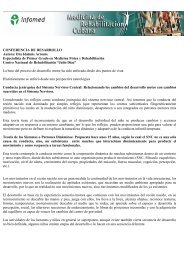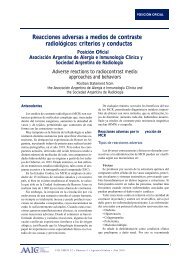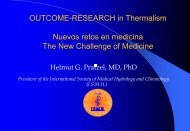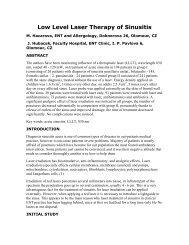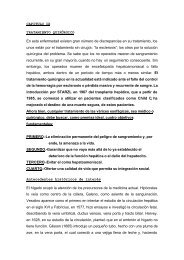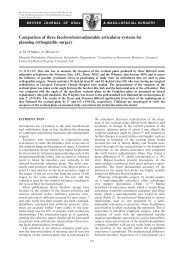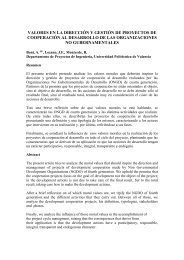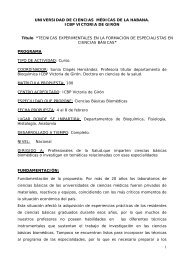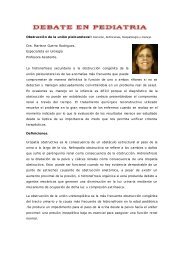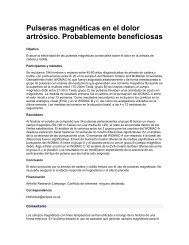Perioperative Anaphylaxis
Perioperative Anaphylaxis
Perioperative Anaphylaxis
Create successful ePaper yourself
Turn your PDF publications into a flip-book with our unique Google optimized e-Paper software.
<strong>Perioperative</strong> <strong>Anaphylaxis</strong> 431<br />
represent the most frequently involved substances, with a range of 50% to 70%,<br />
followed by latex (12% to 16.7%) and, in recent reports, antibiotics (15%) (Table 1).<br />
NEUROMUSCULAR BLOCKING AGENTS<br />
Immune-Mediated Hypersensitivity Reactions<br />
Most hypersensitivity reactions to NMBAs are acute IgE-dependent allergic reactions.<br />
Of all the drugs studied so far that elicit immediate allergic reactions, NMBAs demonstrate<br />
several intriguing departures from the currently accepted explanations of the<br />
mechanisms underlying the allergic immune response to ‘‘small’’ molecules such as<br />
drugs and simple chemicals. 19 Until recently, low molecular weight molecules were<br />
considered as haptens incapable of inducing the production of drug-specific antibodies<br />
by themselves. Consequently, prior covalent binding of the drug or of one of<br />
its degradation products to a protein carrier and processing by professional<br />
antigen-presenting cells before presentation of peptides on the cell surface in close<br />
association with a class I or II histocompatibility molecule were regarded as the initial<br />
steps of sensitization. Recent reports have challenged this dogma. At least some<br />
muscle relaxants bind loosely to plasma proteins; however, there appears to be no<br />
conclusive evidence that covalent conjugation to endogenous proteins to form sensitizing<br />
antigenic drug-protein complexes occurs with any of the NMBAs or their degradation<br />
products. A possible direct interaction with proteins present on the surface of<br />
antigen-presenting cells (class II histocompatibility molecules), as reported for sensitizing<br />
metal and some antibiotics, should also be given consideration. 20 In this regard,<br />
the capacity of dendritic cells, which are considered to be the most powerful antigenpresenting<br />
cells, to present NMBA-related epitopes that are recognized by T cells has<br />
been demonstrated in vitro. 21<br />
The elicitation of an IgE-mediated reaction is influenced by different immunochemical<br />
requirements. In immediate allergic reactions, mast cells and basophils are activated<br />
by cross-linking of Fc3RI molecules, which is thought to occur by binding of<br />
multivalent antigens to the attached molecules. In 1983, Baldo and Fisher demonstrated<br />
the role of alcuronium-reactive antibodies in some life-threatening reactions<br />
elicited by this NMBA. 22 Structure-activity studies designed to explore the molecular<br />
basis of the antibody binding have established that quaternary and tertiary ammonium<br />
ions were the main component of the allergenic sites on the reactive drugs. Because<br />
the structure of NMBAs includes two substituted ammonium ions per molecule, this<br />
divalency could explain allergen-induced mediator release in a sensitized subject<br />
even in the absence of protein binding. 23 The IgE recognition site of the molecule<br />
depends also on the molecular environment of the ammonium ion and on the hydrophobicity<br />
and distance to polar groups such as hydroxyls. 24 This factor may explain<br />
the heterogeneity of the cross-reactivity among patients.<br />
Cross-sensitization among the different agents has been reported to be frequent,<br />
ranging from 60% to 70% of patients allergic to NMBAs, but it is not constant. 10,15,16<br />
Indeed, the patterns of cross-reactivity vary considerably among patients. Crossreactivity<br />
to all NMBAs is relatively unusual but seems to be more frequent with aminosteroid<br />
NMBAs than with benzylisoquinoline-derived NMBAs. 25 In addition to the<br />
previously mentioned steric considerations, which could explain why two muscle<br />
relaxants do not necessarily behave similarly, further hypotheses have been<br />
proposed. In some cases, the antigenic determinant may correspond to the tertiary<br />
or quaternary ammonium epitope or extend to the adjacent part of the molecule.<br />
The relative affinities of the various muscle relaxants to their corresponding IgEs<br />
may also have a role. 26



